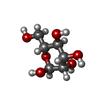+ Open data
Open data
- Basic information
Basic information
| Entry | Database: PDB / ID: 1i8l | ||||||
|---|---|---|---|---|---|---|---|
| Title | HUMAN B7-1/CTLA-4 CO-STIMULATORY COMPLEX | ||||||
 Components Components |
| ||||||
 Keywords Keywords |  IMMUNE SYSTEM / RECEPTORS / IMMUNE SYSTEM / RECEPTORS /  INHIBITORY COMPLEX INHIBITORY COMPLEX | ||||||
| Function / homology |  Function and homology information Function and homology informationnegative regulation of T cell mediated immunity / positive regulation of T-helper 1 cell differentiation / protein complex involved in cell adhesion / positive regulation of signal transduction / negative regulation of regulatory T cell differentiation / RUNX1 and FOXP3 control the development of regulatory T lymphocytes (Tregs) / clathrin-coated endocytic vesicle / CD28 co-stimulation / positive regulation of granulocyte macrophage colony-stimulating factor production / CD28 dependent Vav1 pathway ...negative regulation of T cell mediated immunity / positive regulation of T-helper 1 cell differentiation / protein complex involved in cell adhesion / positive regulation of signal transduction / negative regulation of regulatory T cell differentiation / RUNX1 and FOXP3 control the development of regulatory T lymphocytes (Tregs) / clathrin-coated endocytic vesicle / CD28 co-stimulation / positive regulation of granulocyte macrophage colony-stimulating factor production / CD28 dependent Vav1 pathway / CTLA4 inhibitory signaling / negative regulation of B cell proliferation / Interleukin-10 signaling / CD28 dependent PI3K/Akt signaling /  coreceptor activity / negative regulation of T cell proliferation / positive regulation of T cell proliferation / T cell costimulation / positive regulation of interleukin-2 production / coreceptor activity / negative regulation of T cell proliferation / positive regulation of T cell proliferation / T cell costimulation / positive regulation of interleukin-2 production /  T cell activation / B cell receptor signaling pathway / Constitutive Signaling by Aberrant PI3K in Cancer / positive regulation of peptidyl-tyrosine phosphorylation / virus receptor activity / PIP3 activates AKT signaling / T cell receptor signaling pathway / PI5P, PP2A and IER3 Regulate PI3K/AKT Signaling / T cell activation / B cell receptor signaling pathway / Constitutive Signaling by Aberrant PI3K in Cancer / positive regulation of peptidyl-tyrosine phosphorylation / virus receptor activity / PIP3 activates AKT signaling / T cell receptor signaling pathway / PI5P, PP2A and IER3 Regulate PI3K/AKT Signaling /  adaptive immune response / cellular response to lipopolysaccharide / adaptive immune response / cellular response to lipopolysaccharide /  receptor ligand activity / cell surface receptor signaling pathway / intracellular signal transduction / receptor ligand activity / cell surface receptor signaling pathway / intracellular signal transduction /  immune response / positive regulation of apoptotic process / external side of plasma membrane / DNA damage response / perinuclear region of cytoplasm / positive regulation of DNA-templated transcription / immune response / positive regulation of apoptotic process / external side of plasma membrane / DNA damage response / perinuclear region of cytoplasm / positive regulation of DNA-templated transcription /  Golgi apparatus / Golgi apparatus /  cell surface / cell surface /  plasma membrane plasma membraneSimilarity search - Function | ||||||
| Biological species |   Homo sapiens (human) Homo sapiens (human) | ||||||
| Method |  X-RAY DIFFRACTION / X-RAY DIFFRACTION /  SYNCHROTRON / SYNCHROTRON /  MOLECULAR REPLACEMENT / Resolution: 3 Å MOLECULAR REPLACEMENT / Resolution: 3 Å | ||||||
 Authors Authors | Stamper, C.C. / Somers, W.S. / Mosyak, L. | ||||||
 Citation Citation |  Journal: Nature / Year: 2001 Journal: Nature / Year: 2001Title: Crystal structure of the B7-1/CTLA-4 complex that inhibits human immune responses. Authors: Stamper, C.C. / Zhang, Y. / Tobin, J.F. / Erbe, D.V. / Ikemizu, S. / Davis, S.J. / Stahl, M.L. / Seehra, J. / Somers, W.S. / Mosyak, L. | ||||||
| History |
|
- Structure visualization
Structure visualization
| Structure viewer | Molecule:  Molmil Molmil Jmol/JSmol Jmol/JSmol |
|---|
- Downloads & links
Downloads & links
- Download
Download
| PDBx/mmCIF format |  1i8l.cif.gz 1i8l.cif.gz | 139.3 KB | Display |  PDBx/mmCIF format PDBx/mmCIF format |
|---|---|---|---|---|
| PDB format |  pdb1i8l.ent.gz pdb1i8l.ent.gz | 111.4 KB | Display |  PDB format PDB format |
| PDBx/mmJSON format |  1i8l.json.gz 1i8l.json.gz | Tree view |  PDBx/mmJSON format PDBx/mmJSON format | |
| Others |  Other downloads Other downloads |
-Validation report
| Arichive directory |  https://data.pdbj.org/pub/pdb/validation_reports/i8/1i8l https://data.pdbj.org/pub/pdb/validation_reports/i8/1i8l ftp://data.pdbj.org/pub/pdb/validation_reports/i8/1i8l ftp://data.pdbj.org/pub/pdb/validation_reports/i8/1i8l | HTTPS FTP |
|---|
-Related structure data
| Related structure data | |
|---|---|
| Similar structure data |
- Links
Links
- Assembly
Assembly
| Deposited unit | 
| ||||||||
|---|---|---|---|---|---|---|---|---|---|
| 1 | 
| ||||||||
| 2 | 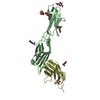
| ||||||||
| Unit cell |
|
- Components
Components
| #1: Protein | Mass: 23892.018 Da / Num. of mol.: 2 / Fragment: EXTRACELLULAR DOMAIN, RESIDUES 35-242 Source method: isolated from a genetically manipulated source Source: (gene. exp.)   Homo sapiens (human) / Production host: Homo sapiens (human) / Production host:   Cricetulus griseus (Chinese hamster) / References: UniProt: P33681 Cricetulus griseus (Chinese hamster) / References: UniProt: P33681#2: Protein |  Cytotoxic T cell / CTLA-4 / CYTOTOXIC T-LYMPHOCYTE-ASSOCIATED ANTIGEN 4 Cytotoxic T cell / CTLA-4 / CYTOTOXIC T-LYMPHOCYTE-ASSOCIATED ANTIGEN 4Mass: 13480.313 Da / Num. of mol.: 2 / Fragment: EXTRACELLULAR DOMAIN, RESIDUES 36-161 Source method: isolated from a genetically manipulated source Source: (gene. exp.)   Homo sapiens (human) / Production host: Homo sapiens (human) / Production host:   Cricetulus griseus (Chinese hamster) / References: UniProt: P16410 Cricetulus griseus (Chinese hamster) / References: UniProt: P16410#3: Sugar | ChemComp-NAG /  N-Acetylglucosamine N-Acetylglucosamine#4: Sugar |  Mannose Mannose |
|---|
-Experimental details
-Experiment
| Experiment | Method:  X-RAY DIFFRACTION / Number of used crystals: 1 X-RAY DIFFRACTION / Number of used crystals: 1 |
|---|
- Sample preparation
Sample preparation
| Crystal | Density Matthews: 6.26 Å3/Da / Density % sol: 58 % | ||||||||||||||||||||||||||||||
|---|---|---|---|---|---|---|---|---|---|---|---|---|---|---|---|---|---|---|---|---|---|---|---|---|---|---|---|---|---|---|---|
Crystal grow | Temperature: 298 K / Method: vapor diffusion, hanging drop / pH: 6.3 Details: 16% PEG 8000, 0.1M CACODYLATE, PH 6.3, VAPOR DIFFUSION, HANGING DROP, temperature 298.0K | ||||||||||||||||||||||||||||||
| Crystal grow | *PLUS Temperature: 18 ℃ / pH: 8 Details: drop consists of equal amounts of protein and reservoir solutions | ||||||||||||||||||||||||||||||
| Components of the solutions | *PLUS
|
-Data collection
| Diffraction | Mean temperature: 100 K |
|---|---|
| Diffraction source | Source:  SYNCHROTRON / Site: SYNCHROTRON / Site:  ALS ALS  / Beamline: 5.0.2 / Wavelength: 1 / Beamline: 5.0.2 / Wavelength: 1 |
| Detector | Type: ADSC QUANTUM 4 / Detector: CCD |
| Radiation | Protocol: SINGLE WAVELENGTH / Monochromatic (M) / Laue (L): M / Scattering type: x-ray |
| Radiation wavelength | Wavelength : 1 Å / Relative weight: 1 : 1 Å / Relative weight: 1 |
| Reflection | Resolution: 3→20 Å / Num. obs: 38815 / % possible obs: 99.2 % / Rsym value: 0.067 / Net I/σ(I): 19.1 |
| Reflection shell | Resolution: 3→3.11 Å / Mean I/σ(I) obs: 3 / Rsym value: 0.351 / % possible all: 94.1 |
| Reflection | *PLUS Num. measured all: 209381 / Rmerge(I) obs: 0.067 |
| Reflection shell | *PLUS % possible obs: 94.1 % / Num. unique obs: 3636 / Rmerge(I) obs: 0.351 |
- Processing
Processing
| Software |
| ||||||||||||||||||||||||||||||||||||||||||||||||||||||||||||||||||||||||||||||||
|---|---|---|---|---|---|---|---|---|---|---|---|---|---|---|---|---|---|---|---|---|---|---|---|---|---|---|---|---|---|---|---|---|---|---|---|---|---|---|---|---|---|---|---|---|---|---|---|---|---|---|---|---|---|---|---|---|---|---|---|---|---|---|---|---|---|---|---|---|---|---|---|---|---|---|---|---|---|---|---|---|---|
| Refinement | Method to determine structure : :  MOLECULAR REPLACEMENT MOLECULAR REPLACEMENTStarting model: HUMAN B7-1 DIMER Resolution: 3→19.77 Å / Rfactor Rfree error: 0.006 / Data cutoff high absF: 162155.86 / Data cutoff high rms absF: 10000 / Data cutoff low absF: 0 / Isotropic thermal model: RESTRAINED / Cross valid method: THROUGHOUT / σ(F): 2 Stereochemistry target values: MAXIMUM LIKELIHOOD USING AMPLITUDES
| ||||||||||||||||||||||||||||||||||||||||||||||||||||||||||||||||||||||||||||||||
| Solvent computation | Solvent model: FLAT MODEL / Bsol: 20.32 Å2 / ksol: 0.252 e/Å3 | ||||||||||||||||||||||||||||||||||||||||||||||||||||||||||||||||||||||||||||||||
| Displacement parameters | Biso mean: 75.3 Å2
| ||||||||||||||||||||||||||||||||||||||||||||||||||||||||||||||||||||||||||||||||
| Refine analyze |
| ||||||||||||||||||||||||||||||||||||||||||||||||||||||||||||||||||||||||||||||||
| Refinement step | Cycle: LAST / Resolution: 3→19.77 Å
| ||||||||||||||||||||||||||||||||||||||||||||||||||||||||||||||||||||||||||||||||
| Refine LS restraints |
| ||||||||||||||||||||||||||||||||||||||||||||||||||||||||||||||||||||||||||||||||
| LS refinement shell | Resolution: 3→3.19 Å / Rfactor Rfree error: 0.024 / Total num. of bins used: 6
| ||||||||||||||||||||||||||||||||||||||||||||||||||||||||||||||||||||||||||||||||
| Xplor file |
| ||||||||||||||||||||||||||||||||||||||||||||||||||||||||||||||||||||||||||||||||
| Software | *PLUS Name: CNS / Version: 0.9 / Classification: refinement | ||||||||||||||||||||||||||||||||||||||||||||||||||||||||||||||||||||||||||||||||
| Refine LS restraints | *PLUS
|
 Movie
Movie Controller
Controller



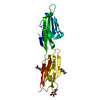
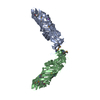

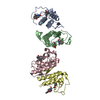
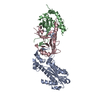



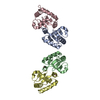


 PDBj
PDBj














